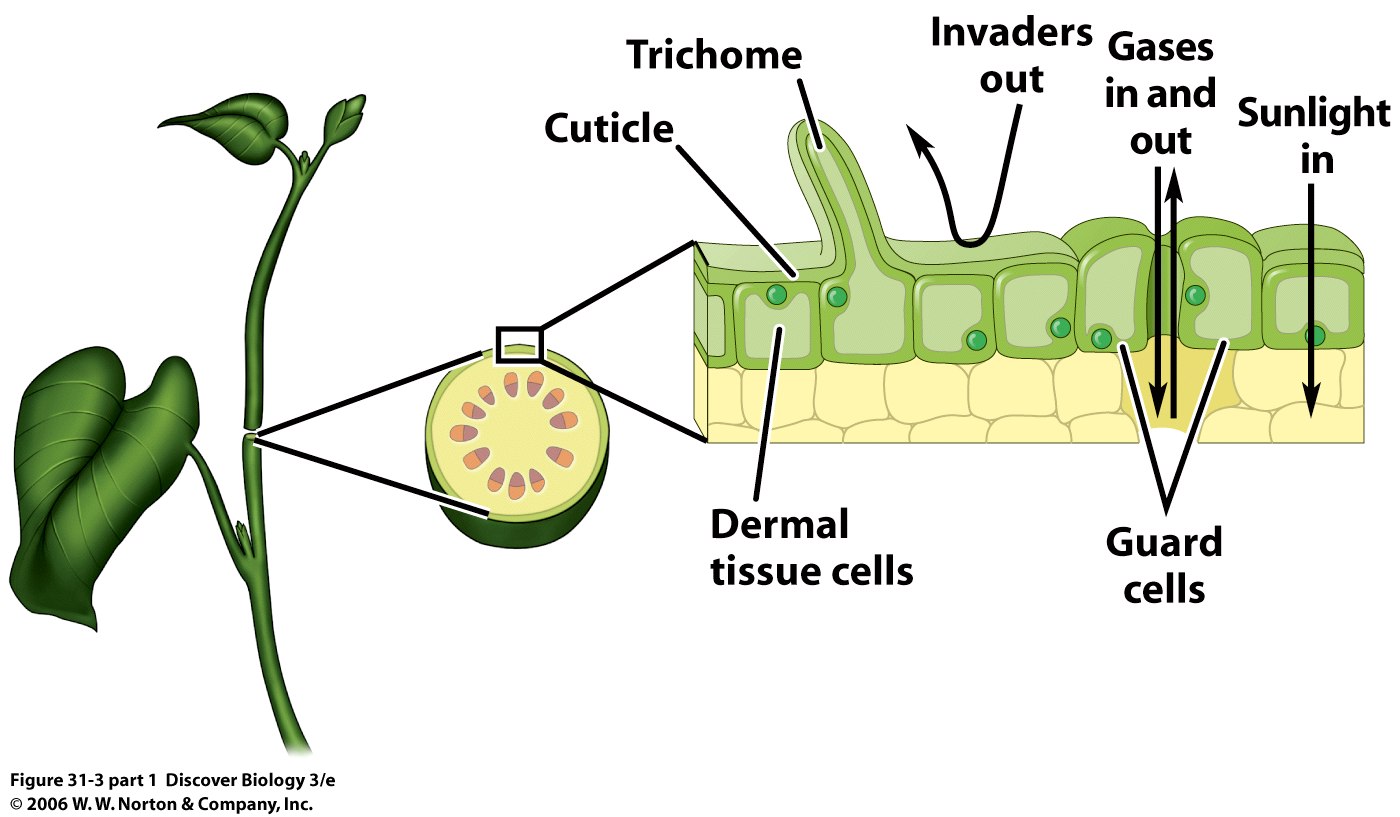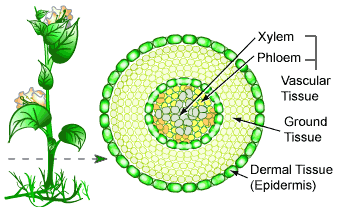Do you know plants also have a tissue system like that of animals and humans? Well yes, like other organisms, plant cells are also grouped into specialized tissues and tissue systems.
Suggested Videos
Classification of Plant Tissue System
Plant tissue systems are broadly divided into three types:
- Dermal Tissue System
- Vascular Tissue System
- Ground Tissue System
Lets now look at each of these plant tissue systems in a little more detail.
Dermal Tissue System
This system consists of Epidermis and Periderm.

The epidermis which is generally a single layer of closely packed parenchymatous cells. Its function is to cover and protect the plant. Depending on the part of the plant that it covers, the dermal tissue system is specialized. The epidermis of a plant contains the stomata which regulate water intake and help in gaseous exchange. The epidermis of leaves secretes a coating called the cuticle which helps the plant retain water. It also forms a protective layer over flowers, fruits, and roots.
The periderm replaces the epidermis in plants that undergo secondary growth. It is multilayered and consists of nonliving cells that cover the outside of stems and roots to protect the plant. The periderm also protects the plant from pathogens, injury, and prevents excessive water loss.
Vascular Tissue System

Source: Google
The vascular tissue system is primarily made up of Xylem and Phloem. The vascular system is responsible for transporting water, minerals, and food across the plant. Xylem and phloem exist in strands called as vascular bundles. Vascular bundles are of three types: Radial, Conjoint and Concentric.
Xylem consists of tracheids and vessels. Xylem is responsible for carrying water and minerals from the roots to the leaves. Vessels are found only in flowering plants but tracheids are found in all vascular plants.
Phloem consists of sieve cells, sieve tubes, phloem parenchyma and phloem fibres. Phloem is responsible for conducting food from the leaves to different areas of the plant. Tracheid cells are nonliving, sieve-tube and companion cells of the phloem are living.
Ground Tissue System
Ground tissue systems are produced by the ground meristems. They are made up of three types of cells: parenchyma, collenchyma and sclerenchyma. Ground tissues synthesize organic compounds and provide support to the plant. In some cases, the ground tissue also stores food in the form of starch.

Source: elte.prompt.hu
- Parenchyma cells found in the ground tissue have not completely lost their ability to divide Most of the plant’s metabolism takes place in these cells. Parenchyma cells in the leaves perform photosynthesis. They contain a large central vacuole and its cytoplasm forms a thin layer adjacent to the cell wall. The cell wall of these cells is composed of cellulose, mostly without any other deposited material. Its secondary cell wall is typically pitted, which indicates plasmodesmal connections between the neighbouring cells.
- Collenchyma cells along with sclerenchyma cells have a supporting function. The collenchyma cells provide support mainly in younger plants. They help support the plants without restraining their growth.
- Sclerenchyma is present in all parts of the plant. It is a long, elongated cell with admirably and evenly thickened cell wall. Into the walls, lignin is deposited, what causes the death of the cells. Due to the composition and structure of the cell walls, sclerenchyma provides an inflexible support, unlike collenchyma which provides flexible support. These cells are derived from the parenchyma. Its two main types are the sclerenchyma fibre and the sclereid.
Solved Example for You
Q: Which of these ground tissues are non-living?
(a) Parenchyma (b) Sclerenchyma
(c) Collenchyma (d) Xylem
Sol. (b) Sclerenchyma
Parenchyma, collenchyma, and sclerenchyma form the ground tissue system in plants. Sclerenchyma are derived from the parenchyma but their cell wall gets lignified and slowly the cells die. Therefore, the sclerenchyma are the non- living ground tissue.






Use the
competitive examination
The apps is very helpful, but in the registration there is no Nigeria phone code?
seems like a good app,but,there countries missing,there is no ZAMBIA There,alot of african countrys not there for registraction,…what do we do for like us to register whose country is not there